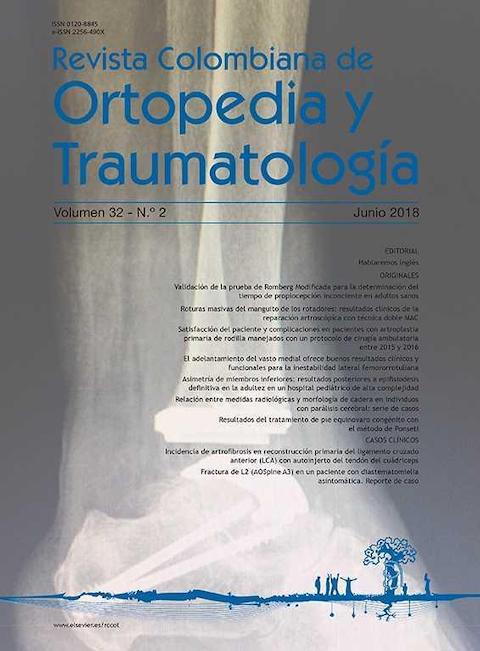Lower limb asymmetry: results after definitive epiphysiodesis at skeletal maturity in a high complexity paediatric hospital
DOI:
https://doi.org/10.1016/j.rccot.2017.09.004Keywords:
leg length discrepancy, epiphysiodesis, complicationsAbstract
Background: The most used surgical treatment in children with leg length discrepancy is permanent percutaneous epiphysiodesis. The purpose of this study is to describe the results at skeletal maturity, as well as the complications in children with leg length asymmetry treated with permanent epiphysiodesis, in a high complexity paediatric hospital since 1993, and to analyse the variables related to the percentage of correction.
Materials and methods: Descriptive, retrospective study, including a review of clinical and radiological records. The study included all patients with a diagnosis of lower limb asymmetry, and who had permanent epiphysiodesis as only treatment, as well as an x-ray at skeletal maturity. A descriptive analysis and a regression analysis were performed between the percentage of correction and predictor variables, gender, aetiology, initial and predicted asymmetry, and at adulthood, method of prediction, and pubertal development. Complications were analysed.
Results: The study included 29 patients, of which 16 were boys, and 21 were congenital. The median age at surgery was 12.1 (range: 10.8-13.6) and 13.7 (range: 11.4-15.2) years in females and males, respectively. Asymmetry at adulthood was less than 2 cm in 69% of cases. The range of the correction percentage was 2.6 to 106.5%, being associated negatively to the presence of advanced puberty (Coeff= -23.9; P=.025) and positively associated with Moseley (Coeff= 38.9; P=.056). The complications included angular deformity in zone 1 (10%).
Discussion: Permanent percutaneous epiphysiodesis was an effective and safe tool for the treatment of leg length discrepancy in our patients. Emphasis is placed on the evaluation of pubertal development during follow-up in order to optimise results at adulthood.
Level of evidence: IV.
Downloads
References
Phemister DB. Epiphysiodesis for equalizing the length of the lower extremities and for correcting other deformities of the skeleton. Mem Acad Chir. 1950;76:758-63.
Bowen JR, Johnson WJ. Percutaneous epiphysiodesis. Clin Orthop Relat Res. 1984;190:170-3. https://doi.org/10.1097/00003086-198411000-00027
Canale ST, Russell TA, Holcomb RL. Percutaneous epiphysiodesis: experimental study and preliminary clinical results. J Pediatr Orthop. 1986;6:150-6. https://doi.org/10.1097/01241398-198603000-00006
Blount WP, Clarke GR. Control of bone growth by epiphyseal stapling; a preliminary report. J Bone Joint Surg Am. 1949;31:464-78. https://doi.org/10.2106/00004623-194931030-00002
Métaizeau JP, Wong-Chung J, Bertrand H, Pasquier P. Percutaneous epiphysiodesis using transphyseal screws (PETS). J Pediatr Orthop. 1998;18:363-9. https://doi.org/10.1097/01241398-199805000-00018
Stevens PM. Guided growth for angular correction: A preliminary series using a tension band plate. J Pediatr Orthop. 2007;27:253-9. https://doi.org/10.1097/BPO.0b013e31803433a1
Makarov MR, Dunn SH, Singer DE, Rathjen KE, Ramo BA, Chukwunyerenwa CK, et al. Complications associated with epiphysiodesis for management of leg length discrepancy. J Pediatr Orthop. 2016.
Inan M, Chan G, Littleton AG, Kubiak P, Bowen R. Efficacy and safety of percutaneous epiphysiodesis. J Pediatr Orthop. 2008;28:648-51. https://doi.org/10.1097/BPO.0b013e3181832475
Lykissasa MG, Jaina VV, Manickamb V, Nathana S, Eismanna EA, McCarthya JJ. Guided growth for the treatment of limb length discrepancy: a comparative study of the three most commonly used surgical techniques. J Pediatr Orthop. 2013;22:311-7. https://doi.org/10.1097/BPB.0b013e32836132f0
Bowen JR, Percutaneous distal femoral o proximal tibial epiphysiodesis. En: Flynn JM, Wiesel SW, editores. Operative Techniques in Pediatric Orthopedics. Philadelphia: Lippincott Williams & Wilkins; 2012.
Shabtai L, Herzenberg JE. Limits of growth modulation using tension band plates in the lower extremities. J Am Acad Orthop Surg. 2016;24:691-701. https://doi.org/10.5435/JAAOS-D-14-00234
Little DG, Nigo L, Aiona MD. Deficiencies of current methods for the timing of epiphysiodesis. J Pediatr Orthop. 1996;16:173-9. https://doi.org/10.1097/01241398-199603000-00007
Moseley CF. A straight-line graph for leg-length discrepancies. J Bone Joint Surg Am. 1977;59:174-9. https://doi.org/10.2106/00004623-197759020-00006
Tachdjian MO, Ortopedia pediátrica. Texas Scottish Rite Hospital for Children. 4th edition. Philadelphia: Saunders Elsevier; 1983.
Marshall WA, Tanner JM, Puberty. En: Falkner F, Tanner JM, editores. Human growth: a comprehensive treatise. Volume 2. Postnatal growth and neurobiology. New York: Plenum Publishing; 1986. https://doi.org/10.1007/978-1-4899-0522-2_8
Sánchez S, Ortega X, Baar A, Lillo S, De la Maza A, Moënne K, Escaffi JA, et al. Asimetría de extremidades inferiores: evaluación por imágenes en la edad pediátrica. Revista Chilena de Radiología. 2013;19:177-86. https://doi.org/10.4067/S0717-93082013000400007
Bayhan IA, Karatas AF, Rogers KJ, Bowen JR, Thacker MM. Comparing percutaneous physeal epiphysiodesis and eight-plate epiphysiodesis for the treatment of limb length discrepancy. J Pediatr Orthop. 2015;37:323-7. https://doi.org/10.1097/BPO.0000000000000647
Song MH, Choi ES, Park MS, Yoo WJ, Chung CY, Choi IH, et al. Percutaneous epiphysiodesis using transphyseal screws in the management of leg length discrepancy: optimal operation timing and techniques to avoid complications. J Pediatr Orthop. 2015;35:89-93. https://doi.org/10.1097/BPO.0000000000000214
Mielke CH, Stevens PM. Hemiepiphyseal stapling for knee deformities in children younger than 10 years: A preliminary report. J Pediatr Orthop. 1996;16:423-9. https://doi.org/10.1097/01241398-199607000-00002
Ministerio de Justicia y Derechos Humanos. Presidencia de la nación argentina. Ley 25.326. Protección de los datos personales, 2000.
Campens C, Mousny M, Docquier PL. Comparison of three surgical epiphysiodesis techniques for the treatment of lower limb length discrepancy. Acta Orthop Belg. 2010;76:226-33.
Kemnitz S, Moens P, Fabry G. Percutaneous epiphysiodesis for leg length discrepancy. J Pediatr Orthop B. 2003;12:69-71. https://doi.org/10.1097/01202412-200301000-00013
Koczewski P, Fryzowicz A. Phemister epiphysiodesis in leg length inequality treatment-evaluative outcome analysis. Ortop Traumatol Rehabil. 2013;15:315-23. https://doi.org/10.5604/15093492.1073830
Gorman TM, Vanderwerff R, Pond M, Mac Williams B, Santora SD. Mechanical axis following staple epiphysiodesis for limb-length inequality. J Bone Joint Surg Am. 2009;91:2430-9. https://doi.org/10.2106/JBJS.H.00896
Dewaele J, Fabry G. The timing of epiphysiodesis. A comparative study between the use of the method of Anderson and Green and the Moseley Chart. Acta Orthop Belg. 1992;58:43-7.





